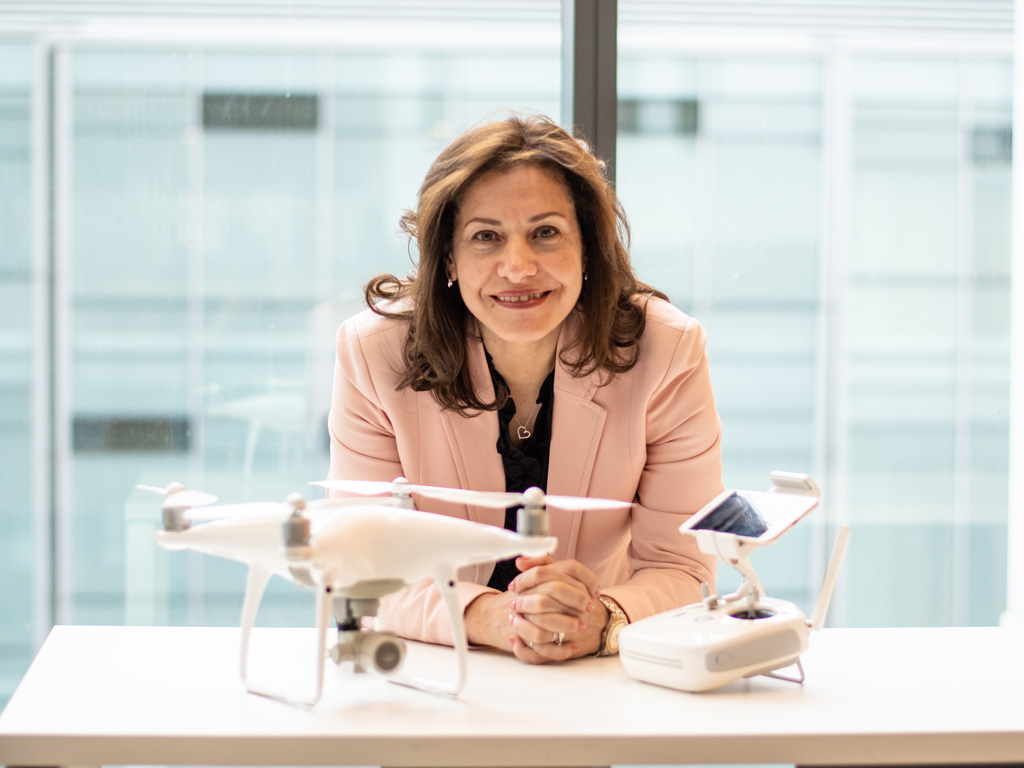Missing Persons Search: Drones to the Rescue

The setting was Cairo, Egypt, mid-afternoon, October 1992. Ryerson’s Dalia Hanna still remembers the 5.8 magnitude earthquake that devastated her city, leaving hundreds dead and thousands injured. Looking back, Hanna recalls the now-primitive search efforts: no Google Maps, no GPS, no drones. Only a bunch of paper maps, cut up and distributed to rescue workers sifting through the rubble.
Now completing her PhD in Computer Science, Hanna is immersed in research to improve search-and-rescue (SAR) technology. Her focus: human-robot interaction and unmanned aerial vehicles (UAVs), or drones. Working under Dr. Alex Ferworn of Ryerson’s computer science research group, Network-Centric Applied Research Team (NCART), Hanna presented her findings at the 10th IEEE Information Technology, Electronics and Mobile Communications Conference (external link) .
Predicting Survivability of Lost Dementia Patients
Hanna’s work concentrates on searches for dementia patients – a population with the highest injury rates among lost persons studied in a (PDF file) 2011 report (external link) . Hanna cites the need for tactical efficiency: “Six out of ten dementia patients end up wandering. They don’t know they’re lost, so they just keep walking and walking until hypothermia or dehydration set in. Minutes count.”
Conventional ground searches involve volunteers, police and dogs on foot. Helicopters may be deployed, but costs are often prohibitive. Hanna proposes drones instead: “They’re much cheaper and can quickly cover a lot of ground.”
Hanna is investigating the feasibility of automation by programming drones to find missing persons. She explored factors such as age, sex, quality of care, terrain, total time away – any clues that might improve the chances of recovering individuals safe and alive. Patterns could then be used in designing algorithms to direct the drones.
Data Scrubbing, Analytics and R
Collaborator and SAR expert, Robert J. Koester, provided Hanna with access to the International Search and Rescue Incident Database. Hanna mined its collection of 50,000 SAR reports and harvested over 3,200 dementia cases.
Before the data was usable, Hanna and Ryerson’s Chang School collaborator Riyad Husein, had to scrub and augment it. “There were lots of missing pieces,” says Hanna. “We had to cut and cut, and then make reasoned calculations until we had a more fulsome picture.”
Hanna manually cleaned the data herself, but also found the R programming language useful in automating some analyses and in visualizing the findings. She then applied three methods to classify the data. Two resulted in overfitting and errors. Only the Synthetic Minority Oversampling Technique (SMOTE) provided reasonably accurate results for predictive modelling.
OPP Field Test Simulations
Hanna also worked with the Ontario Provincial Police to simulate searches using drones. Hanna explains: “We connected a volunteer to a GPS and had him wander in the woods while a drone pilot conducted the search.”
The team collected details, including the wanderer’s walk path, distance traveled, drone battery life and other data. “The tests were really fun,” Hanna recalls. “Software development is usually all machines, but this was on the ground and very human.”
Human Interaction Still Needed
In the end, few predictive patterns emerged. “We can’t say that if the weather is good, or patients exhibit a certain behaviour, they’ll be found in a certain spot,” says Hanna. “But we do know that they don’t wander far – most within ten kilometers of home.”
Another discovery: the longer they’re missing, the higher probability that dementia wanderers will be found harmed or deceased. The findings validate drone use in search operations. “Drones may locate patients more efficiently, while saving on costs, personnel and other resources.”
Hanna’s work could also play a role in creating game simulations to train emergency responders, or in improving policy making or data collection practices involving missing persons. Yet, full SAR automation remains elusive. “Some aspects can be programmed into drones,” Hanna predicts, “but we still need a search manager’s experience and judgment to direct the operations.” Meanwhile, research to optimize human-robot interactions continues.
Hopeful for the Future of SAR
Reflecting on her work and on dementia’s far reaching impact, Hanna is contemplative: “During my presentations, 99% of my audiences raise their hands when asked if they’ve somehow been touched by the illness – as a friend, family or caregiver. If I can make even a small difference – as simple as helping them find loved ones a little bit faster, that’s significant,” Hanna concludes. “It’s very meaningful.”
Hanna’s work is funded partially by NSERC CREATE, AGE-WELL and Ryerson University.